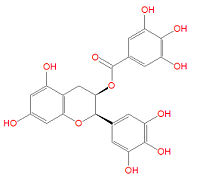Epigallocatechin gallate (EGCG): Difference between revisions
Jump to navigation
Jump to search

imported>Daniel Mietchen m (intrawiki) |
mNo edit summary |
||
| Line 5: | Line 5: | ||
== References == | == References == | ||
<references/> | <references/>[[Category:Suggestion Bot Tag]] | ||
Latest revision as of 06:00, 13 August 2024
(-)-Epigallocatechin gallate, often called EGCG, is a chemical of the flavonoid kind that is found in green tea and herbal supplements which proponents suggest provides healthful benefits. Recent scientific literature has shown it inhibits the formation of amyloid fibrils or agrregates.[1]
References
- ↑ D.E. Ehrnhoefer, J. Bieschke, A. Boeddrich, M. Herbst, L. Masino, R. Lurz, S. Engemann, A. Pastore & E.E. Wanker (2008). "EGCG redirects amyloidogenic polypeptides into unstructured, off-pathway oligomers". Nature Structural & Molecular Biology 15: 558-566. DOI:doi:10.1038/nsmb.1437. Research Blogging.
